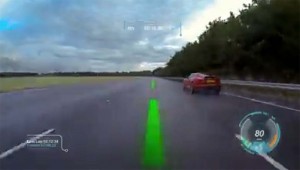Head-Up Displays are the norm in modern fighter jets, and basic versions of HUD have been used in a number of automobiles for more than two decades. But Jaguar Land Rover is working on a concept , dubbed the Virtual Windshield, that could take automotive displays a giant further, effectively bring videogames to life.
The new system is designed to project across the entire windshield, not just a mirrored rectangle at the bottom of the glass. And it could display a wide range of information, depending upon whether you’re driving in heavy traffic, cruising on a back road, or perhaps taking a vehicle like the F-Type Coupe out on the track.
The virtual windshield might be used to display not only vehicle speed, RPMs, fuel levels and basic, turn-by-turn navigation instructions but, because the proposed display would be so large, it could also show warnings – highlighting a pedestrian crossing the road, for example – and even the best line to take on a track.
The system also could be paired with in-car sensors that might read a driver’s hand gestures or even interpret where one’s eyes are looking.
“We have identified which functions still need to be controlled by physical buttons and which could be controlled by gesture and carefully calibrated motion sensors,” said JLR’s Director of Research and Technology Dr. Wolfgang Epple. “The system is currently being tested on a number of features including sunblinds, rear wipers and satellite navigation maps.
(Ford Mobii app could let motorists view the inside of their cars remotely. Click Here for more.)
Head-Up Displays offer a number of potential advantages over conventional gauges and even more modern video displays. For one thing, a motorist doesn’t have to take their eyes off the road, a process that can delay a driver’s reaction in an emergency.
A teaser video released by Jaguar illustrates some of the ways the system might be used. When racing, for example, a virtual line would show the fastest and safest way around a corner. And when it comes time to brake, the line could change color. In fact, the system could display the way a racer handled previous laps, giving the driver a chance to improve their performance.
The system also could be linked to outside cameras allowing the manufacturer to eliminate traditional rear and sideview mirrors.
(New 3D system helps Honda more accurately simulate crash tests, speed safer cars to market. Click Here to check the technology out.)
The JLR system is designed to track a driver’s eyes so that it can project images in virtual 3D without requiring the use of special goggles.
Other makers have been working to improve their HUD systems. One of the most advanced on the market is offered as an option on the new Mercedes-Benz S-Class. But the Jaguar Land Rover virtual windscreen would leapfrog existing systems.
That is, of course, if it actually makes it into production. The maker isn’t saying whether or when it might plan to offer the Virtual Windscreen on an F-Type or Range Rover, nor is it ready to discuss pricing.
But Eppel hints, “It has the potential to be on sale within the next few years.”

